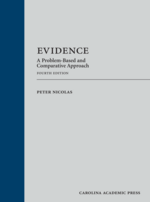This title has been replaced by a newer edition:
Evidence: A Problem-Based and Comparative Approach, Fourth Edition
2018, 1010 pp, casebound, ISBN 978-1-5310-0403-3
$149.00
Teacher's Manual available
Evidence
A Problem-Based and Comparative Approach
Third Edition, Revised Printing
2014
Tags: Evidence
Teacher's Manual available
888 pp $105.00
ISBN 978-1-61163-572-0
eISBN 978-1-61163-586-7
To access the 2016-17 Supplement to this book, click here.
This casebook provides a comprehensive, problem-based approach to studying the rules of evidence. Organized around the federal rules, this casebook provides coverage of every single
rule; yet, through careful case choice and editing, Professor Nicolas has produced a book that can easily be taught from cover-to-cover in as few as three semester hours.
Key features of the casebook include approximately 115 in-depth problems that are designed to teach all the nuances of the rules, as well as coverage of selected state rules of evidence that differ significantly from the federal rules designed to facilitate class discussion about the policies underlying the rules of evidence. In addition, the casebook contains an enriched section on scientific evidence, in-depth coverage of the rules to electronic evidence, and a chapter on appellate review of evidentiary rulings.
The revised third edition of the casebook builds on the strengths of previous editions while at the same time updating it to reflect recent developments. The text has been revised to reflect the language of the Restyled Federal Rules of Evidence as well as all substantive amendments through December 2013. The revised third edition contains edited versions of the Supreme Court's most recent Confrontation Clause decisions, including Melendez-Diaz v. Massachusetts, Michigan v. Bryant, Bullcoming v. New Mexico, and Williams v. Illinois. The revised third edition also includes recent decisions applying the rules of evidence to electronic evidence, including cases involving information found on social networking websites. In addition, it contains expanded coverage of state rules of evidence that differ significantly from the federal rules. Finally, in an effort to keep the book manageable in length, Professor Nicolas has—as a general rule—tried to remove a page of material for every new page added.
An annual supplement is produced each year that includes the latest developments in evidence law so as to keep the textbook up-to-date between editions. A separate statutory supplement
includes the federal rules of evidence and selected legislative history. In addition, the Teacher's Manual includes detailed answers to all of the problems contained in the casebook.



